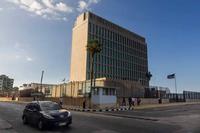In the fall of 2003, defense industry reporter Sharon Weinberger was sitting through yet another Capitol Hill briefing on Pentagon weaponry, when a fellow in the back of the room mentioned something called a "hafnium bomb." Weinberger had never heard of it. So she turned around and asked the guy what the hell a hafnium bomb was. The question started Weinberger on a two-year "journey through the Pentagon's scientific underground." By the time she was done, Weinberger had run into eavesdropping kittens, wormhole builders, antimatter rocketeers, psychic CIA agents, intelligent designists, and cold fusion true believers. But most importantly, she became deeply intertwined with a far-flung coalition of Defense Department-backed scientists who believed that they could construct nuclear hand grenades out of bits of the radioactive isotope hafnium-178 -- despite mountains of evidence to the contrary. It's all chronicled in Weinberger's fascinating, disturbing, wickedly funny new book, Imaginary Weapons.
The question started Weinberger on a two-year "journey through the Pentagon's scientific underground." By the time she was done, Weinberger had run into eavesdropping kittens, wormhole builders, antimatter rocketeers, psychic CIA agents, intelligent designists, and cold fusion true believers. But most importantly, she became deeply intertwined with a far-flung coalition of Defense Department-backed scientists who believed that they could construct nuclear hand grenades out of bits of the radioactive isotope hafnium-178 -- despite mountains of evidence to the contrary. It's all chronicled in Weinberger's fascinating, disturbing, wickedly funny new book, Imaginary Weapons.
Weinberger's story centers around Carl Collins, a Texas scientist turned nuclear Don Quixote, who convinces Pentagon and Energy Department officials to spend millions on his jousts with the laws of physics. The fact his windmill-tilting relies on a second-hand X-ray machine, taken from a dentist's office, doesn't seem to matter. Or that his Romanian wife has a sketchy choke-hold over the hafnium supply. Or that every scientific panel the Pentagon assembles calls Collins' work bunk. Or that no reputable physicist can replicate his hafnium experiments.
Luckily for Collins, "no one remembers the failure," Weinberger quotes Darpa chief Tony Tether as saying. "That allows us to try again and again Darpa is Groundhog Day. We do things over and over again." For years, it seems, Tether and others in Defense Department woke up every morning convinced that the Russians were about to have a hafnium bomb. It took a near-Herculean effort to finally persuade them that it might not be true.
In the book and over the next few days, in a series of exclusive posts for Defense Tech Weinberger shows how dangerous the amnesiac attitude is for the nation's security. But God, is it good for readers. Weinberger is a master observer, capturing the sights and sounds surrounding the inanity and near-insanity of military fringe science, from the puffed-up research claims to the hushed denials, based on questionable secrecy. Scientists wax poetic about the beauty of mushroom clouds. Google searches for hafnium turn up an Alabama physicist, who sees the isomer's intricacy as a sign of intelligent design. Supposedly landmark experiments are commemorated by stryfoam cups marked "Dr. C's memorial target holder." Imaginary Weapons can lay the physics on a little thick for the lay reader, at times. But mostly, accompanying Weinberger on her trip through the Pentagon's pseudo-science netherworld is madcap, farcical fun. Here's an excerpt:
Hafnium went to the Pentagon by way of New Mexico, helped along by a cadre of believers in the Air Force. One of those, of course, was Forrest "Jack" Agee, the Air Force scientist in charge of funding basic physics. He was the man who, in 1999, started funding Collins, while also publishing with him.
In early 2004, I went to visit Agee at his office in Arlington, Virginia.
Standing in front of the nondescript building that housed the Air Force Office of Scientific Research, I stopped for a moment to take in the gray faade that showed little sign of military occupancy. Office workers shuttled in and out of the multistory building, and it wasn't until I arrived at the Air Force's floor that a halfhearted attempt at military security was on display. A sullen woman reading a copy of People shoved a red badge at me, barely glancing at my press credentials.
Agee, once described to me as the eminence grise behind isomers, smiled as I entered his office and extended his hand like a caretaker greeting a mourning relative on their way to buy a casket. It was the last time he smiled. With dark-tinted glasses and a dour demeanor, Agee did not seem like the type of military official to give interviews, and I was surprised, in fact, that he had agreed to speak to me at all. Maybe he was surprised, too, because as soon as we sat down at the small oval table in his office, he immediately looked uncomfortable. Seated at the table, I noticed that Agee had a corner office, but with the windows blocked at every angle by adjacent buildings, casting the room in a permanent gloomy haze.
To Agee's right sat a public affairs official, and to his left, a security officer, who as Agee explained, was there to make sure he didn't say anything classified.
What secrets could accidentally slip out, I wondered?...
When I asked him about the controversial nature of the [hafnium] work, particularly the scientific debate around Collins's hafnium triggering experiment, Agee frowned deeply. "I know that work is going on around the world in this area," he said. "We are familiar with a number of countries that are pursuing this."
Agee paused for a moment to clear his throat and glanced out the window with its plaintive view of the next buildingperhaps thinking about the legions of foreign countries that could be eavesdropping on our conversation about dreaded isomer weapons.
He cleared his throat again, and then continued: "It was a surprise that Japanese torpedoes worked in a shallow harbor in 1941. We were technologically surprised by that and with awesome impact. So, the fact that there are countries other than ours that are working on this, well, we better be able to know what this is about whether we ever find an application for it or not, in case others find that." ?
I was struck that just about every government scientist I'd met had described their job as preventing "technological surprise," but something like the isomer weapon was only a threat if it worked, or had a reasonable chance of working, I pointed out An expert panel of scientists had essentially said the hafnium bomb couldn't work, or at least had about as much a chance of being a bomb as a jelly donut. Was there really any legitimate fear of isomer bombs raining down on the United States anytime in the near-to-distant future?
Agee scoffed.
"We rely on more than just a few days' review by some panelalbeit populated by smart people," he said.
UPDATE 06/14/06 12:06 PM: Carl Collins drops by to respond, here.








